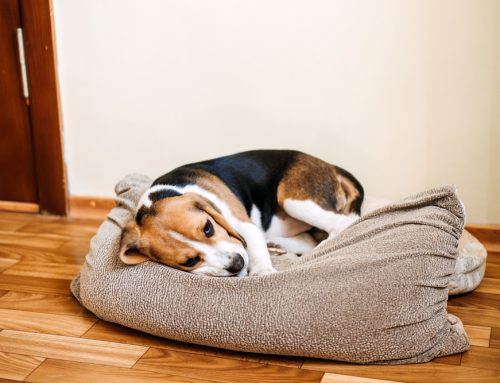If your pet became extremely attached to you during the pandemic shutdown, they may experience separation anxiety now that you have returned to work. Our team at Willow Wood Animal Hospital wants to offer tips to help you manage this problematic condition, and alleviate your pet’s distress.
#1: Recognize separation anxiety signs in pets
Separation anxiety can be triggered when a pet is surrendered to a shelter, their schedule changes, their residence changes, or a family member moves away or dies. These pets can experience extreme distress, and may panic when their owner leaves them alone, resulting in possible physical and mental problems. Signs differ between cats and dogs.
- Dogs — Behaviors seen in dogs suffering from separation anxiety include:
- Following their owner
- Becoming anxious before their owner leaves
- Vocalization
- Destructive behavior
- Inappropriate elimination
- Pacing
- Frantic escape attempts
- Self-destructive behavior
- Salivation
- Vomiting
- Refusal to eat
- Excessively greeting their owner on their return home
- Cats — Behaviors seen in cats suffering from separation anxiety include:
- Inappropriate elimination, often on the owner’s personal items
- Persistent meowing
- Refusing to eat
- Excessive grooming
- Clawing curtains or furniture
- Knocking over objects
- Excessively greeting their owner on their return home
#2: Rule out other conditions that could be affecting your pet
Other conditions can cause behaviors similar to separation anxiety. For example, pets who are bored can exhibit destructive behavior when their owners leave them alone; however, the behaviors typically resolve if the pet exercises more, or is provided environmental enrichment. Several medical conditions may also cause signs in pets similar to those affected by separation anxiety, including:
- Urinary tract infection — Pets affected by a urinary tract infection may inappropriately eliminate.
- Gastrointestinal upset — Pets who have a gastrointestinal condition, such as food allergies or exocrine pancreatic insufficiency (EPI), may inappropriately eliminate.
- Cognitive dysfunction syndrome (CDS) — Older pets may experience CDS, a condition similar to Alzheimer’s disease in humans. Pets with CDS may forget their house training, become more anxious, and cling more to their owner.
If you suspect your pet is suffering from separation anxiety, allow our veterinary professionals to evaluate them, to rule out a medical issue. Videotaping your pet while you are away can help distinguish between separation anxiety and another condition, because affected pets typically display specific behavior patterns, such as becoming distressed immediately after their owner leaves.
#3: Desensitize your pet to your departure cues
Your pet learns to associate your pre-departure rituals with your leaving, and they can become anxious before you walk out the door. Desensitize your pet to these cues, so they no longer associate your leaving with specific tasks, such as picking up your keys, or putting on your coat. You can do this by exposing your pet to these cues several times a day, but not leaving. For example, you can pick up your keys and put on your coat, and then watch television. Do this many times a day for several weeks until your pet no longer becomes anxious when you perform these tasks.
#4: Practice graduated departures with your pet
Once your pet remains calm despite your departure cues, you can start practicing graduated departures.
- Inside door — Start by having your pet remain on the other side of an inside door in your home, such as the bathroom. You can use your pre-departure cues during these practice sessions by picking up your keys, putting on your coat, and then going in the bathroom. Gradually increase the time you spend in the room, until your pet does not become anxious.
- Exit door — You can progress to practicing this exercise at an exit door. If you normally leave through the front door, do the exercise at the back door first. Initially, stay gone only one to two seconds, gradually working up to longer sessions.
- Food puzzle toy — Once you have worked up to 10-second absences, start counterconditioning, by offering your pet a food puzzle toy before you step out the door.
- Calm demeanor — Stay calm and quiet when you go in and out, which will decrease the contrast between your presence and your absence.
#5: Provide mental and physical stimulation for your pet

Exercising your pet’s mind and body can greatly enrich their life, decrease their stress, expend excess energy, and provide outlets for normal behavior. Suggestions include:
- Exercise — Have your pet participate in aerobic activity before you leave the house every day. Walking, jogging, or a strenuous fetch game are good options for dogs, and laser pointers or wand toys are good choices for cats.
- Playtime — Spend at least 10 to 15 minutes twice a day interacting with your pet.
- Mealtime — Feed your pet using a food puzzle toy, and offer their morning meal before you leave for the day.
- Environmental enrichment — Ensure your pet can watch wildlife outside the window, provide a vertical landscape for cats, and leave the television or music playing.
#6: Consider medicating your pet
Anti-anxiety medications and supplements are available that may benefit your pet. Our American Animal Hospital Association-accredited veterinary professionals can help you decide if these products are appropriate for your pet.
Separation anxiety can be upsetting for you and your pet, but following these tips can help reduce your pet’s distress. If your pet’s behavior is still concerning, contact our Willow Wood Animal Hospital team, so we can determine the cause of the problem.







Leave A Comment